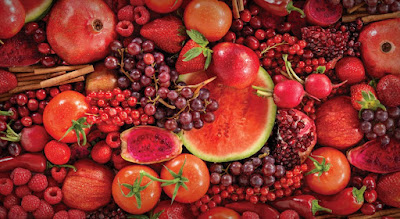Red veggies
consist of tomatoes, red peppers, red onions, and red cabbage are packed with vitamin
C, vitamin A, potassium and antioxidants.. These colorful and tasty foods are
gifts from nature. They offer many health benefits because they have some of
the following nutrients; lycopene, quercetin, hesperidin, fiber, vitamin A and
vitamin C.
Some of those benefits include:
- Reducing the risk of prostate cancer.
- Protecting the body from prostate, cervical and lung
cancer.
- Reducing tumor growth.
- Protecting the body from harmful free radicals.
- Protecting the body against heart disease.
- Lowering blood pressure.
- Lowering LDL cholesterol, which is the bad cholesterol
in the body.
- Supporting joint tissue for those with arthritis.
1.
Red Tomatoes
If you want the most exquisite accompaniment to any dish,
look no further. Tomatoes are flavorful, healthful vegetable. The main compound
in tomatoes is lycopene which is researched for its valuable health
benefits.
Because the high content of lycopene, tomatoes are
considered beneficial for sunburn
protection. Furthermore, clinical studies show that lycopene could be helpful
in lowering LDL
cholesterol.
2.
Beets
These colorful root veggies are low in calories, but high in
essential nutrients as Vitamin B9, Manganese, Iron, Vitamin C. Beets have high
levels of nitrates which have been studied for their blood pressure lowering
properties.
The nitrates are also linked to increased athletic performance.
Beets are an excellent source of dietary fiber, and you can easily include them
in your diet.
3.
Red Cabbage
Even though it looks more purple than red, this cabbage has
impressive health benefits. The color comes from the presence of anthocyanins.
Only one cup of cabbage has 85% of the RDV for Vitamin C, 42% of the RDV for
Vitamin K and 20% of the RDV Vitamin A.
Because of the high content of Vitamin C, the cabbage is a
great immune system booster and provides protection from oxidative stress.
According to one study,
the best way to get the most nutrients is if you eat the cabbage raw.
4.
Red Bell Pepper
The red bell pepper is one of the most abundant sources of
Vitamin C. One medium sized red bell pepper has 169% of the RDV for Vitamin C.
The healthy antioxidants available in bell peppers (capsanthin, violaxanthin,
lutein, quercetin, luteolin) make them outstanding healthy food.
Consuming bell peppers has been linked to reduced risk of
chronic diseases and improved eye health.
5.
Radishes
Radishes often underestimated root vegetable, are
exceptional for your health. They have only nine calories in half cup which
makes them an ideal snack.
The high fiber
content in radishes will help you feel full and satisfied, so you can maintain
a healthy weight and maybe even shed a few pounds.
They can also help with detoxification, heart and skin
health. So don’t wait, snack on radishes and obtain all the wonders of their
nutrition.
6.
Red Chili Pepper
The main bioactive compound in red chili peppers is
capsaicin which is responsible for the burning taste, but also for the
remarkable health benefits. The capsaicin can promote weight loss by increasing
fat burning.
7.
Radicchio
This plant is often confused with red cabbage. It has
characteristically bitter taste, and it’s a great flavorful addition to your
salads. It’s good for the heart because of the Vitamin K content which helps in
prevention of calcification of the arteries.
On the other hand, the high concentration of Vitamin K in
radicchio helps for healthy, strong bones.
8.
Red Leaf Lettuce
The red leaf lettuce has characteristic red-tinged leaves.
This vegetable has a very high concentration of Vitamin A. One serving (85g)
has 127% of the RDV for vitamin A. The high content of fiber and water make you
feel full which can help in your weight management plan.
9.
Red Onion
Even though many people dislike their pungent flavor, we
cannot deny that onions are packed with antioxidants, making them a powerful
vegetable. The sulfur compounds in red onions help for lowering LDL cholesterols which result
in improved cardiovascular health.
The red onions are also a good source of chromium which aids
in blood sugar regulation. You can reduce the bad breath after eating onions by
consuming herbs like parsley, cilantro, rosemary or peppermint.
10.
Red Sweet Potatoes
Red potatoes are a fantastic source of vitamin A.
Based on a research red potatoes are healthier than regular potatoes. They have
more fiber and lower glycemic index. The skin of red potatoes has twice the
antioxidants than white potatoes.
The high content of antioxidants can help in reducing free radicals.

